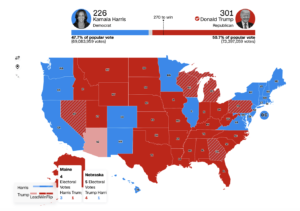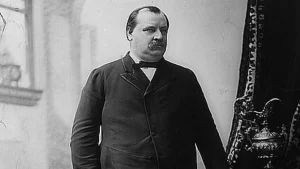
By: Abbas Changezi
Donald Trump has achieved what many thought impossible: returning to the presidency in a dramatic and historic victory. Overcoming a series of formidable obstacles—including narrow opinion polls, legal battles, and skeptical media narratives—Trump decisively won the 2024 U.S. presidential election. Garnering over 51% of the popular vote and more than 300 Electoral College votes, he reclaimed the White House with a renewed mandate. His triumph marks one of America’s most extraordinary political comebacks, drawing comparisons to past leaders who returned to power after defeat.
Overcoming Polls and Predictions
Leading up to the election, most national polls indicated an advantage for Democratic candidate Kamala Harris. Analysts anticipated a close race hinging on pivotal swing states such as Pennsylvania, Michigan, and Arizona. Defying these forecasts, Trump secured victories in all key battlegrounds, reaffirming traditional Republican strongholds and winning over undecided voters. For the first time in his political career, Trump won both the popular vote and the Electoral College—an achievement that eluded him in 2016 when Hillary Clinton had the popular vote edge.
Historical Context: A Return Not Seen Since Cleveland
Only one president in U.S. history, Grover Cleveland, managed to return to the White House after an electoral defeat, serving as both the 22nd and 24th president in the late 19th century. In modern times, losing presidential candidates have typically exited the political stage or taken on advisory roles. Trump, however, defied this norm. After his loss in 2020 and subsequent legal and political battles, including a failed attempt to contest the results, he spent three years solidifying his support base, navigating Internal party divisions, and planning his next move.

Election Night Drama
On election night, Trump and his supporters gathered at a convention center in Florida. As results trickled in, the atmosphere shifted from anticipation to celebration as Trump’s path to victory became evident. In typical Trump fashion, he preempted mainstream media by declaring victory himself, taking to the stage surrounded by family members, influential allies like Elon Musk, and a mix of supporters spanning the worlds of business, media, and sports.
“Many people have told me that God spared my life for a reason, and that reason was to save our country and to restore America to greatness,” Trump declared. He emphasized his commitment to securing borders, reviving the economy, and calling for national unity—a rare note of conciliation in his speech.
Former Donald Trump holds hands with former First Lady Melania Trump at the Palm Beach County Convention on election night, in West Palm Beach, Florida, Wednesday, Nov. 6, 2024.
The Democrats’ Defeat
While Trump celebrated, Kamala Harris’s campaign event in Washington, D.C., took a somber turn. Initially marked by optimism, the night’s excitement waned as the results painted a grim picture. With Trump claiming over 300 Electoral College votes, Harris ended up with only 224. The loss extended beyond the presidency, as early projections indicated the Democratic Party was poised to lose its majority in the U.S. Congress.

Congress Shifts Right
The Republicans, also known as the “Grand Old Party” GOP resurgence was not limited to the presidential race. Out of 34 Senate seats up for grabs, the GOP managed to unseat several Democratic senators, regaining control of the Senate for the first time since 2021. Meanwhile, the House of Representatives remained undecided but appeared to be tilting Republican, signaling a potential GOP sweep of the executive and legislative branches.
The Road Ahead: Trump 2.0
Trump’s first term was marked by confrontation—battles with the press, contentious relations with Congress, and numerous legal challenges to his executive actions. His return prompts questions about whether he will adopt a more seasoned, strategic approach or reprise his polarizing leadership style. Thus far, his campaign speeches suggest he may lean into familiar rhetoric, promising to be uncompromising in pushing his agenda.
Policy Priorities
Central to Trump’s new term is a focus on energy independence and economic protectionism. His rallying cry of “drill, baby, drill” indicates a commitment to expanding domestic oil production to combat inflation and lower fuel prices. Another major policy shift involves the introduction of sweeping tariffs: a proposed 10% levy on all imports and a more aggressive 60% on goods from China, a move experts caution could provoke inflation and economic repercussions.
Immigration reform remains a top priority, with Trump planning mass deportations and invoking an obscure 1798 law to facilitate this. If pursued, this policy will likely face significant legal obstacles and logistical challenges. Additionally, Trump aims to dismantle elements of the Affordable Care Act (Obama Care), reverse recent gun restrictions, and cut funding for climate initiatives, including electric vehicle subsidies.
Potential Team Changes and Alliances
Trump’s inner circle in his new term may differ significantly from his previous administration. While Ivanka Trump and Jared Kushner were notable presences during his first tenure, they remained absent from the 2024 campaign. Meanwhile, figures like Elon Musk, whom Trump lauded on election night for his contributions to American industry, could play influential roles. Another significant name is Robert F. Kennedy Jr., whom Trump may appoint to a key public health position—a move that would align with the president’s skepticism of conventional health policies.
What This Means for America
Trump’s unprecedented return to the White House, coupled with a likely Republican majority in Congress, suggests a period of significant policy shifts. The GOP’s control could enable Trump to appoint judges, reshape bureaucracies, and enact sweeping legislative changes. The next four years promise to be marked by ambitious, controversial policy pushes that could redefine America’s domestic and foreign landscape.
Trump’s comeback is one for the history books—a rare and impressive feat of political resilience. Yet, with a volatile mix of bold policies and familiar contentiousness, the nation waits to see whether his second term will be a turning point that fulfills his promise of a “golden age” or deepens the divides that have marked his political career. The story of Trump’s return is not just about his victory; it’s about what comes next for the United States.
